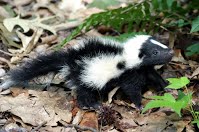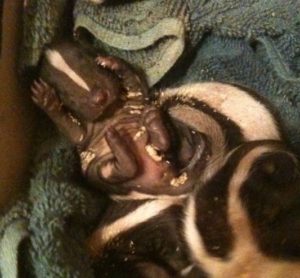BABY SKUNK(S)

Staying with their biological parent is their best chance of survival.

1. OBSERVE
Where did you find the baby?
Skunks are very near-sighted and follow their mother nose-to-tail. They sometimes lose sight of her when a car or dog scatters them. As baby skunks get older, they sometimes come out to explore around the den site (such as under your deck or shed), while the mother is away. Most of the time, they don’t appear without her (all alone), particularly during the day.

Monitor from a distance to see if their mother returns. Keep all people and pets away from the area.

2. REUNITE
Is the baby alone?
If a baby skunk or group of baby skunks are wandering around alone and there is no reason to believe that the mother is dead, place an upside-down plastic laundry basket (with lattice sides so the skunks are visible) over them. This will serve to temporarily contain the skunk(s) while waiting for mom to return. When using this method, approach the skunk slowly and talk softly. If the skunk gives a warning by stamping his/her front feet, stand still. Approach again after the skunk calms down. There’s no need to put a weight on top of the laundry container. When the mother returns, she will flip up the basket and retrieve her young. Since skunks are generally nocturnal, you will want to give the mother plenty of time and until well after dark to retrieve her babies.
Is the baby in danger?
If a baby skunk has fallen into a window well, often the mother is still around even if it’s daytime. Place a kitchen garbage can on its side and put the open end facing the baby. When s/he walks into it, tilt the garbage can upwards and raise him/her out of the window well. If the mother is nearby, release the baby by putting the garbage can on its side so s/he can walk out, and she can retrieve him/her. If the mother is not present, put an upside-down laundry basket over the baby (the kind with lattice sides that she can see through), to hold him/her in place until the mother returns to retrieve the baby, usually by dusk. She will flip the basket up with her nose as long as there’s no weight on top. Be sure to get a window well cover from a local home building store so this problem does not recur.
Do not feed the baby!
Not only do they require a specialized diet but the baby could suffocate if not fed properly.

Call for help if:
The Baby Is Injured
If the baby is sick, injured or cold, the baby needs immediate assistance.
Dead Adult/Mother Found With Babies
If the baby is orphaned, s/he will need help and needs to stay warm while waiting for help to arrive.
Has Parasites
If the baby has with fly eggs (yellow dots, “rice” or flakes) or a heavy parasite load (ticks, fleas), that indicates a baby who has not been tended to by the mother and needs help right away!

Baby Is Repeatedly Seen Alone
Is vocalizing or looking sickly or weak, contact a rehabilitator for help.
As a result of trapping:
If a baby skunk (or group of baby skunks) is repeatedly seen alone outside, contact a wildlife rehabilitator for assistance. This kind of orphaning often occurs when a neighbor has trapped and removed the mother skunk from the area. The babies get so hungry waiting for mom to return, that they venture out looking for her, starving. Trapping is a terrible way to resolve “nuisance” problems, especially during baby season because it results in orphaned young or dying babies under decks and sheds.
